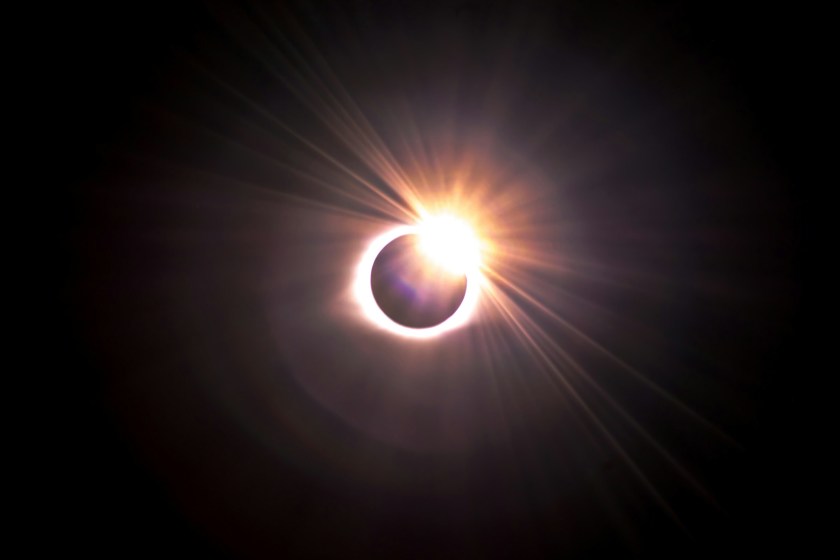Buy One, Get One 50% OFF Eyeglasses
* Restrictions apply. Ask a Team Member for details.

How to Protect Your Eyes During The 2024 Solar Eclipse
Written by Dr. Elaine Ramos, OD, Nationwide Vision
The United States is about to experience one of the most amazing spectacles on Earth – a Solar Eclipse! This rare astronomical event where the Moon perfectly blocks out the Sun is set to take place on April 8, 2024. While only a small portion of the country will see what’s known as totality (when the Moon perfectly covers the Sun), the rest of the continental United States will still be able to observe the Moon slowly blocking a portion of the Sun.
But don’t look up just yet! There are some important things to know about the dangers of trying to watch this event without the proper equipment.
As an optometrist at EyeCare Partners, I stress the importance of understanding proper solar eclipse-watching techniques. It's crucial to ensure you're equipped with the appropriate gear to safeguard your eyes before participating in this thrilling celestial event. Failing to take the necessary precautions could result in irreversible damage to your eyes.
Why Isn’t it Safe to Look at a Solar Eclipse?
When the Sun is shining on a typical day, it is far too bright to stare at it, even with polarized sunglasses. In fact, staring at the Sun’s harmful rays for too long (even a few seconds!) can cause severe damage to your eyes, a condition known as solar retinopathy. When you stare at the Sun, you are placing the center of your vision, the fovea, directly into the light’s path. The Sun’s intense light then causes damage to the fovea and surrounding retinal cells, causing blurry vision or even loss of central vision.
While the Moon’s shadow is cast over parts of the Earth during an eclipse, it does not perfectly block out all light, even if you are within the path of totality. This means that the actual intensity of light coming from the Sun doesn’t decrease one bit and can still cause this condition to occur. Another name for solar retinopathy is actually eclipse retinopathy because of how dangerous this event is on the eyes. Even if it seems like the light isn’t as bright, the light that still makes it to your eyes is just as intense as any other day. This is why staring directly at the solar eclipse without any protection is going to place your eyes at a significant risk for damage.
See how much of the Sun will be blocked where you live using the Eclipse Cities tracker!
How to View the Solar Eclipse Safely
There are a number of different methods you can use to view the solar eclipse without putting your vision in jeopardy.
Eclipse Glasses
The safest way to directly view a solar eclipse with your own eyes is to purchase a reputable pair of solar eclipse glasses. These special glasses are like extremely strong sunglasses. They’re upwards of 100,000 times darker than the ones you wear on a typical sunny day. Their design allows you to look directly at the Sun without having any side effects or risks of damaging your eyes.
Solar eclipse glasses must be certified through a specific international standard known as ISO 12312-2. An extensive list of reputable sellers can be found through the American Astronomical Society.
Observatory Events
If you live near an observatory, there’s a good chance that they will host a community event during the eclipse that not only provides education for you and your family, but may also provide eclipse glasses for safe viewing at their facilities. In addition, many observatories will likely have a high-definition video display to provide a more enhanced viewing opportunity. This is an excellent option for anyone not within the path of totality.
Do It Yourself Sun Viewer
The last option you can do as a crafts project for kids (adults, too!) is to make your own Sun Viewer. The name of this is slightly misleading, as you should never look directly at the Sun, especially with this device. A Sun Viewer acts more as your own movie screen inside of a cardboard box – the longer the box, the larger the image!
Enjoy this Rare Moment
This solar eclipse will surely be an incredible event for the country. In fact, the continental United States isn’t expected to experience this again for another 20 years! So before you go out to soak it all in, make sure that your eyes are protected so that you don’t have an unexpected visit to your eye doctor the next day.

About the Author: Dr. Elaine Ramos, OD
Dr. Elaine Ramos, OD, received her Bachelors of Science degree from California State University, Fullerton and earned her Doctorate of Optometry from Marshall B. Ketchum University. She completed a residency in vision therapy and neuro-rehabilitation from the State University of New York College of Optometry.
Prior to joining Nationwide Vision, Dr. Ramos was an assistant professor at Western University College of Optometry in Pomona, CA and adjunct professor at Midwestern University in Glendale, AZ where she practiced in the pediatrics and vision therapy clinics. She currently resides in Peoria, AZ with her husband, baby girl, and corgi named Butters.